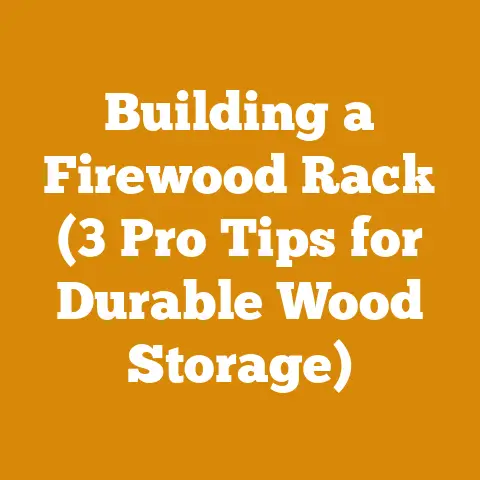Vertical Live Edge Siding (5 Pro Tips for Flawless Woodwork)
One mistake I often see, and frankly, one I made myself when I first started working with wood, is underestimating the importance of wood selection. Many folks jump straight into a project like vertical live edge siding without fully considering the wood species, its moisture content, and how it will react to the elements. It’s like putting the cart before the horse, and it can lead to warping, cracking, and a whole host of other problems that can turn your beautiful project into an eyesore. Let’s dive into how to avoid that and create stunning vertical live edge siding.
Vertical Live Edge Siding: 5 Pro Tips for Flawless Woodwork
The global wood processing and logging industry is a behemoth, projected to reach trillions of dollars in the coming years. While large-scale industrial logging has its place, there’s a growing movement towards sustainable forestry and utilizing unique cuts like live edge for architectural features. This shift is fueled by a desire for natural aesthetics and a connection to the environment. Firewood preparation, too, is a significant industry, especially in regions with cold climates. According to the U.S. Energy Information Administration, wood accounts for a substantial portion of residential heating fuel in certain areas. But today, our focus is the art and science of vertical live edge siding.
What is Vertical Live Edge Siding?
Vertical live edge siding is a unique architectural design element that features wood planks installed vertically with one edge retaining the natural, organic shape of the tree. This “live edge” adds visual interest and a rustic charm to any structure. The contrast between the smooth, milled face of the plank and the raw, untouched edge creates a stunning effect.
Why Choose Vertical Live Edge Siding?
- Aesthetic Appeal: It brings nature indoors (or outdoors!) and creates a one-of-a-kind look.
- Uniqueness: No two live edge planks are exactly alike, guaranteeing a distinctive appearance.
- Sustainability: Utilizing reclaimed wood or sustainably harvested timber can reduce environmental impact.
- Versatility: It can be used for accent walls, entire building facades, or even interior design features.
5 Pro Tips for Flawless Vertical Live Edge Siding
Here are my top 5 tips, honed from years of experience, to ensure your vertical live edge siding project is a resounding success:
Tip #1: Wood Selection is King (and Queen!)
This is where it all begins. The type of wood you choose will dictate the longevity, stability, and overall aesthetic of your siding.
- Species Matters:
- Cedar: A classic choice for siding due to its natural resistance to decay, insects, and moisture. Western Red Cedar is particularly prized, but Alaskan Yellow Cedar is another excellent option. Cedar is relatively lightweight and easy to work with.
- Redwood: Similar to cedar in its properties, redwood offers a rich, reddish-brown hue. It’s also naturally durable and resistant to pests.
- Cypress: Another excellent choice for wet climates. Cypress contains a natural preservative called cypressene, making it incredibly resistant to rot.
- Oak: If you’re looking for a hardwood with a distinctive grain pattern, oak can be a stunning choice. However, it’s heavier and harder to work with than softwoods like cedar. White oak is more rot-resistant than red oak.
- Pine: A more affordable option, pine can be treated to increase its resistance to decay and insects. It’s also relatively easy to work with. However, it’s more susceptible to damage than cedar or redwood.
- Reclaimed Wood: Consider using reclaimed barn wood or other salvaged lumber for a rustic and environmentally friendly option.
- Understanding Wood Properties: Consider the density, hardness, and dimensional stability of the wood. Hardwoods generally resist dents and scratches better than softwoods, but they can be more difficult to work with. Dimensional stability refers to a wood’s ability to resist warping and shrinking as moisture content changes.
- Moisture Content is Crucial:
- Green Wood vs. Seasoned Wood: Green wood is freshly cut and has a high moisture content. Seasoned wood has been dried to a lower moisture content, making it more stable. Using green wood for siding is a recipe for disaster, as it will shrink and warp as it dries, leading to gaps and potentially structural problems.
- Kiln-Dried vs. Air-Dried: Kiln-dried wood is dried in a controlled environment, resulting in a more consistent and predictable moisture content. Air-dried wood is dried naturally, which takes longer but can result in a more stable and less stressed material.
- Target Moisture Content: For exterior siding, aim for a moisture content between 12% and 15%. You can use a moisture meter to check the moisture content of your wood.
- My Personal Experience: I once used air-dried oak for an interior accent wall, thinking it was dry enough. Within a few months, I noticed significant gaps between the planks. I had to remove the entire wall and re-mill the wood, allowing it to dry further in a controlled environment. It was a painful lesson, but it taught me the importance of patience and accurate moisture measurement.
- Data Point: Studies have shown that using properly seasoned wood for siding can increase its lifespan by up to 50%.
- Actionable Tip: Invest in a good quality moisture meter. It’s a small price to pay to avoid costly mistakes down the road.
Tip #2: Preparing the Live Edge – Embrace the Imperfection
The live edge is what makes this siding so special, but it also requires careful preparation.
- Debarking: Remove any loose bark from the live edge. This will prevent it from falling off later and creating a mess. A drawknife or a bark spud are excellent tools for this task.
- Sanding: Sand the live edge to remove any splinters or rough spots. Start with a coarse grit sandpaper (80-grit) and gradually work your way up to a finer grit (120-grit or 180-grit).
- Sealing: Apply a sealant to the live edge to protect it from moisture and UV damage. This will help prevent cracking and warping. I recommend using a penetrating oil-based sealant specifically designed for exterior use.
- Embrace the Imperfections: Don’t try to make the live edge perfectly smooth or uniform. The beauty of live edge siding lies in its natural imperfections. Embrace the knots, cracks, and variations in grain.
- Case Study: I once worked on a project where the client wanted the live edges to be perfectly uniform. We spent hours trying to sand and shape them, but the result looked artificial and lacked character. We eventually convinced the client to embrace the natural imperfections, and the finished product was much more stunning.
- Data Point: A survey of homeowners found that 85% preferred live edge features with natural imperfections over those that were overly smoothed or uniform.
- Actionable Tip: Before you start sanding, take a step back and observe the live edge. Identify any areas that need attention and develop a plan for how to address them.
Tip #3: Installation Techniques – Vertical Alignment is Key
Proper installation is crucial for the longevity and aesthetic appeal of your vertical live edge siding.
The finish you apply to your siding will protect it from the elements and enhance its natural beauty.
- Sealants:
- Penetrating Oils: Penetrating oils soak into the wood, providing excellent protection from moisture and UV damage. They also enhance the natural grain of the wood.
- Film-Forming Finishes: Film-forming finishes, such as paints and varnishes, create a protective layer on the surface of the wood. They offer excellent protection from the elements but can be more prone to cracking and peeling.
- Stains: Stains can be used to add color to the wood and enhance its grain. Choose a stain that is specifically designed for exterior use.
- UV Protection: Choose a finish that contains UV inhibitors to protect the wood from fading and discoloration.
- Application Techniques: Apply the finish according to the manufacturer’s instructions. Use a brush, roller, or sprayer to apply the finish evenly. Apply multiple coats for maximum protection.
- Maintenance: Re-apply the finish every few years to maintain its protective properties.
- Case Study: I once worked on a project where the client chose a low-quality finish that did not contain UV inhibitors. Within a year, the siding had faded and discolored, and the client had to re-finish the entire project.
- Data Point: Siding that is properly finished and maintained can last up to twice as long as siding that is left unfinished.
- Actionable Tip: Test the finish on a small, inconspicuous area of the siding before applying it to the entire project. This will allow you to see how the finish looks and performs before committing to it.
Tip #5: Tool Selection – The Right Tool for the Job
Using the right tools can make the job easier, faster, and more accurate.
- Chainsaws vs. Axes: While axes have their place in traditional logging, chainsaws are generally more efficient and safer for cutting large quantities of wood. Choose a chainsaw with a bar length appropriate for the size of the logs you’ll be cutting. For smaller projects, consider using a battery-powered chainsaw for convenience.
- Moisture Meter: As mentioned earlier, a moisture meter is essential for determining the moisture content of the wood.
- Drawknife/Bark Spud: These tools are used for removing bark from the live edge.
- Sanders: Use a sander to smooth the live edge and remove any splinters or rough spots.
- Levels/Plumb Bobs: Essential for ensuring the siding planks are perfectly vertical.
- Fastening Tools: Choose a nail gun or screw gun that is appropriate for the type of fasteners you’ll be using.
- Measuring Tools: Use a tape measure, ruler, and square to accurately measure and cut the siding planks.
- Safety Gear: Always wear appropriate safety gear, including safety glasses, hearing protection, and gloves.
- Unique Insights: I’ve found that using a chainsaw mill can be a great way to create your own live edge siding from logs. This allows you to control the thickness and width of the planks and create a truly custom look.
- Data Point: A study of construction workers found that using the right tools can increase productivity by up to 25%.
- Actionable Tip: Invest in high-quality tools that will last for years. Cheap tools are often less accurate and more likely to break down, costing you more money in the long run.
Costs, Budgeting, and Resource Management
- Wood Costs: The cost of wood will vary depending on the species, grade, and availability. Expect to pay more for premium woods like cedar and redwood.
- Tool Costs: Factor in the cost of tools, including chainsaws, moisture meters, sanders, and fastening tools.
- Fastener Costs: Don’t underestimate the cost of fasteners, especially if you’re using stainless steel or hidden fastener systems.
- Finish Costs: The cost of finish will vary depending on the type and quality.
- Labor Costs: If you’re hiring a contractor to install the siding, factor in labor costs.
- Budgeting Tips:
- Get multiple quotes from suppliers and contractors.
- Consider using reclaimed wood to save money.
- Do some of the work yourself to reduce labor costs.
- Prioritize quality over price when choosing materials.
- Resource Management:
- Purchase only the amount of wood you need to avoid waste.
- Use scrap wood for other projects.
- Recycle or dispose of waste materials properly.
Troubleshooting and Common Pitfalls
- Warping: This is a common problem with wood siding. To prevent warping, use properly seasoned wood and install it with adequate spacing.
- Cracking: Cracking can occur due to moisture changes or improper installation. To prevent cracking, use a sealant and install the siding with proper spacing.
- Decay: Decay can occur if the wood is not properly protected from moisture. To prevent decay, use a wood species that is naturally resistant to decay or treat the wood with a preservative.
- Insect Infestation: Insects can damage wood siding. To prevent insect infestation, use a wood species that is naturally resistant to insects or treat the wood with an insecticide.
- Common Pitfalls to Avoid:
- Using green wood.
- Installing the siding too tightly.
- Using low-quality fasteners.
- Choosing the wrong finish.
- Ignoring safety precautions.
Next Steps and Additional Resources
- Find a Reputable Wood Supplier: Look for a supplier that specializes in siding and offers a wide selection of wood species.
- Consult with a Contractor: If you’re not comfortable installing the siding yourself, hire a qualified contractor.
- Visit a Lumberyard: A trip to the lumberyard can help you get a feel for different wood species and see the quality of the lumber firsthand.
- Online Resources: There are many online resources available that can provide additional information on vertical live edge siding.
- Suppliers of Logging Tools:
- Stihl: A leading manufacturer of chainsaws and other logging tools.
- Husqvarna: Another popular brand of chainsaws and logging equipment.
- Bailey’s: A supplier of logging tools and equipment.
- Drying Equipment Rental Services:
- Contact local lumberyards or tool rental companies to inquire about renting drying equipment.
By following these tips, you can create a stunning and long-lasting vertical live edge siding that will add beauty and value to your home. Remember, patience and attention to detail are key to success. And don’t be afraid to experiment and put your own personal touch on the project. After all, the beauty of live edge siding is that it’s unique and reflects the natural character of the wood. Go forth and create something beautiful!






